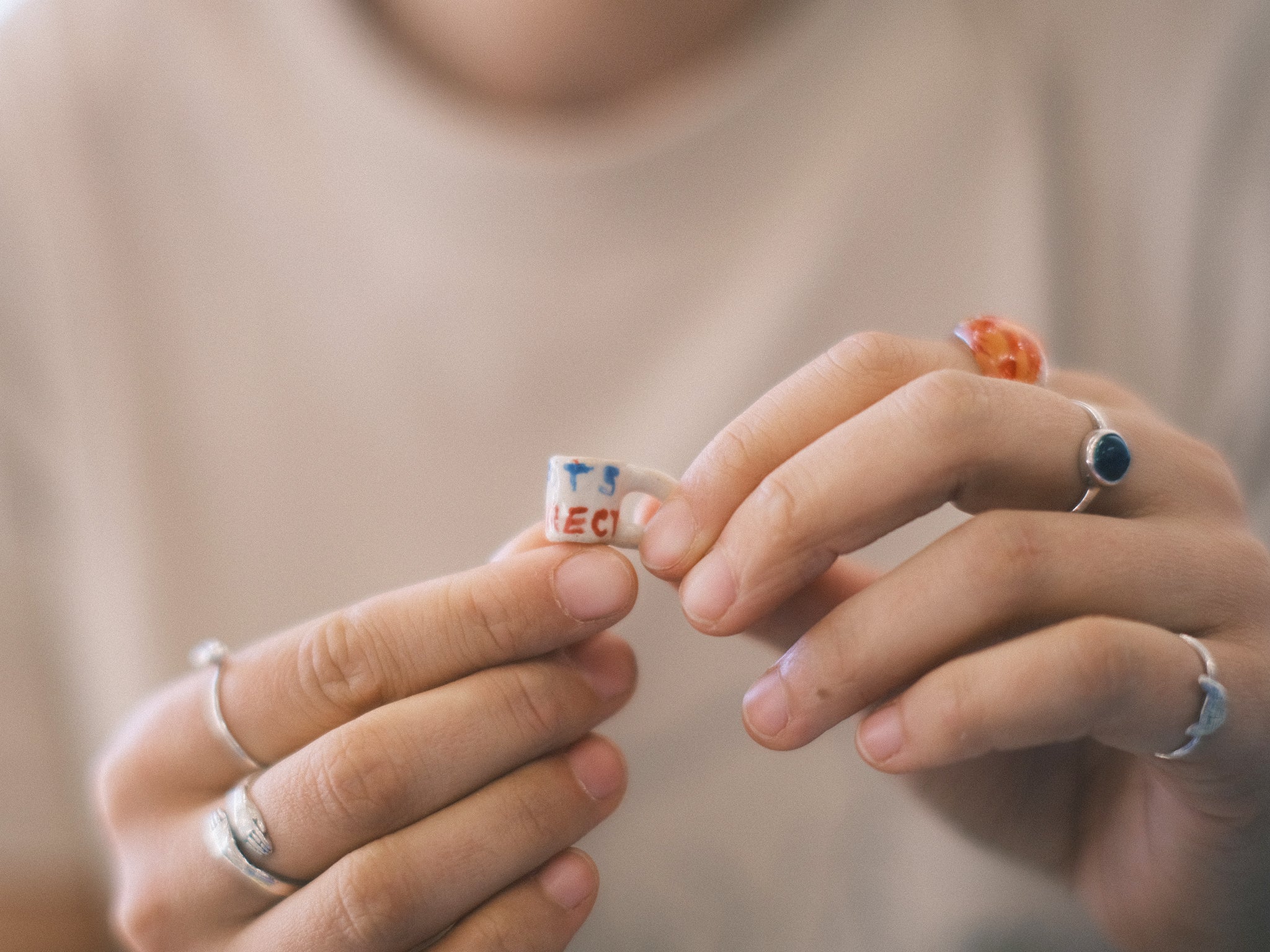From fine bone china to, er, Sports Direct: How Britain became obsessed with mugs
Nothing enrages British people more than a slight change to our mug habits, from the loss of a precious bit of fine china, to the indignity of having to drink our tea from a branded office mug. Sarah Ingram speaks to experts and mug fans about our weirdest national pastime


When Ross Cowie goes on holiday, alongside the suncream and flip flops, he’ll always pack one of his favourite mugs. Careful not to leave any of them out of the international travel experience, he’ll take a different one each time. “They’re like little babies to me, so it’s like picking a favourite child,” he says. “You’d be surprised how many people pack a mug.”
For many of us, the vessel from which we take our morning brew is the first and most important decision of the day. It’s a uniquely British obsession. We have cupboards crammed with too many cups; the favourite ones, the gifted ones, the chipped ones, the outdoor ones. But please God, no, not that one. Not the massive Sports Direct one. The wrong mug can affect your mood for hours. How to describe the hurt you feel when a chipped mug containing the wrong-coloured tea lands on your desk at work or – gulp – one that is black inside? And what kind of a monster electively drinks from a corporate mug?
According to the UK Tea and Infusions Association, we drink more than 100 million cuppas every day in the UK. That makes us the third largest tea-drinking nation per capita, behind Turkey and the Republic of Ireland. Yet many of us are much more relaxed about the brand of tea we drink than the cup it comes in. Bone china or ceramic? Fluted lip or straight? Round or square? These are decisions that divide a nation.
Cowie, a senior product developer at tableware supplier Pure Table Top, says that a surprising amount of thought goes into the three-month mug design process, including the “emotional response and durability and connection” it creates. This plays out in the shape of the handle, the size of bowl, what it’s made from and how it’s decorated. Cowie, who dubs himself a ceramics detective (he can identify the make, maker and factory of most cups without turning them upside down), has designed more than 500 mugs, and his company makes millions a year. One of his latest, a “hug mug” with a large bowl and plenty of space in the handle for two sets of fingers, is designed to invoke a sense of comfort, enabling the drinker to wrap both hands around the cup and enjoy its warmth. Cowie’s nightmare is those white, utilitarian, too-small coffee cups that you get at conferences; identikit beakers of bleakness, designed for stacking rather than solace, delivering the saddest cups of tea ever served. To be presented with one of these would be a “huge disappointment”, Cowie says.
“In the UK, we do mugs like nobody else,” he adds. “I go to factories around the world and I ask to see what mug shapes they have, and they’re baffled because we’re the only country with such diversity. Elsewhere, it’s a much more functional thing. Retailers – even in Europe – won’t have a mug wall like shops do here. It’s really important to British culture; we’re all tea fiends.”
When the leaf first came to the UK on the trade winds from China 350 years ago, it was a novelty. Served only in fancy coffee houses, tea was expensive and perplexing – no one knew exactly what to do with it. As its popularity grew, it was heavily taxed and became a luxury afforded only to the upper classes.
“Tea was really seen as a status symbol,” explains writer and tea enthusiast Eileen Donaghey, who is known as The Afternoon Tea Expert. “So when the concept of taking tea at other friends’ homes became popular, the focus was not only on the tea but what vessel it was drunk from. This trickled down to all classes, and you’d often hear that people would keep their ‘best china’ for visitors.”
Donaghey, who hosts luxury tea experiences, takes her brew in a delicate cup: “Personally, I think that tea tastes much better if it’s drunk from a fine bone china cup, because the flavour stays in the tea without sticking to the inside of the cup. Note a cup, not a mug, which would be reserved for coffee. It’s lighter and the rim is thinner. A true teacup should have a rounder bottom while a coffee cup is normally square.”
That’s the shape covered, but what about the hue? Why do some people only drink out of certain coloured mugs? “There has been research to suggest that red tea cups make tea taste better, as we associate the colour red with brightness or sweetness,” she explains. “Some people refuse to drink out of cups with an inside which is black. This is really because they cannot see the tea clearly and don’t know how well it is brewed. A white inside is usually better.”
When the Sports Direct mug arrives for free after you place a large online order, it’s not the accident many consumers think it is
When it comes to hygiene, it is a truth universally acknowledged that there are only two kitchen items that do not need to be washed after each use: bread knives and mugs. But there is a scientific reason some of us don’t rinse our cups. The flavour of the tea is affected by the porousness of the mug, and some materials absorb the tastes and aromas of the tea over time, making each successive brew richer and more flavoursome, according to tea mixologist Krisi Smith, creative director of Bird & Blend Tea Co. “At a molecular level, the type of cup or teapot – be that porcelain, china or clay – or the size of your mug will change the taste and experience of your tea,” she says. “Some larger mugs are not just great for wrapping your hands around, but also allow more space for the tea to brew and therefore oxygen to further the flavour and aroma development.”
This is all very nice. But we’re skirting around the real issue here. What about those ugly, giant Sports Direct mugs ubiquitous to every cupboard, canteen and office desk? Where did they come from? Why are they so big? And how did they get everywhere? Sports Direct has remained tight-lipped around the issue, but there must be hundreds of thousands across the nation, colonising our spaces with their red and blue bulk. It’s not a conspiracy though, says Andy Barr, the CEO of digital PR and social agency 10 Yetis. “When the mug arrives for free after you place a large online order, it’s not the accident many consumers think it is,” he says. “It’s actually a strong strategic marketing move.”
Despite the size, audacity, and complete lack of ergonomic sophistication of the Sports Direct mug, many have grown to love them. At least one bar in Deptford, London, serves cocktails out of them, while designer and potter Veronika McQuade makes miniature “Sports Indirect” mugs which she gives out as Christmas gifts to friends and relatives. (She also makes miniature figures which she hands out instead of Christmas cards.) Heather Welford, a writer from Newcastle, has two Sports Direct mugs on rotation which enable her to consume the gallons of tea needed to fuel her work. She says: “Their size is perfect for the amount of tea I need, especially in the morning when I might have two full cups. No one else uses them. I honestly don’t know how they came into my cupboard, but I’m glad they did.”

And there is a feel-good factor about the ritual of tea taken in the right mug. We switch the kettle on to connect with others. We give beautiful cups to people we love. And we reward ourselves for a job well done with a 30-second stare while the kettle boils. Clare Sandiford, a counsellor who designs mugs with clients as part of an art therapy practice, says the humble mug can help ground us in uncertain times.
“We crave security, love and support,” she says. “Using the same mug each day feels comforting. So no matter what you’re going through at the time, using that mug is reinforcing the message: ‘You can do this. You’re not alone.’”
Join our commenting forum
Join thought-provoking conversations, follow other Independent readers and see their replies
Comments


Bookmark popover
Removed from bookmarks